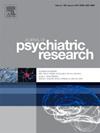Investigating the potential link between bruxism and obsessive-compulsive symptomatology: An exploratory study
IF 3.2
2区 医学
Q1 PSYCHIATRY
引用次数: 0
Abstract
Objective: This study aimed to investigate the relationship between bruxism and obsessive-compulsive symptomatology, and understanding the positioning of bruxism within the framework of obsessive-compulsive spectrum disorders. Material and Method: The study included 80 individuals with bruxism, 78 with obsessive-compulsive disorder (OCD), and 82 healthy participants. All groups were administered the Bruxism Questionnaire, Maudsley Obsessive Compulsive Inventory, Patient Health Questionnaire-9, Generalized Anxiety Disorder Test-7, and Yale General Tic Severity Scale. Results indicated that total scores on the Maudsley Obsessive Compulsive Inventory, as well as subscale scores for checking, cleanliness, slowness, doubting, and rumination, were significantly higher in the OCD group compared to the bruxism group, and higher in the bruxism group than the control group. When controlling for anxiety and depression scores, the differences in total and controlling subscale scores of the Maudsley Obsessive Compulsive Inventory between the bruxism and control groups remained significant. The frequency of bruxism was higher in the OCD group compared to the control group. Additionally, total tic scores in the bruxism group were higher than those in the healthy control group. In conclusion, this study provides important insights regarding the classification of bruxism in psychiatry. It suggests that bruxism should have a definitive position in psychiatric classification, alongside its existing place in neurology and dentistry. This perspective is anticipated to enhance treatment outcomes for bruxism in clinical settings, particularly for cases unresponsive to conventional treatments.
调查磨牙症与强迫症症状之间的潜在联系:一项探索性研究
目的:探讨磨牙症与强迫症症状的关系,了解磨牙症在强迫症谱系障碍中的定位。材料与方法:本研究包括80名磨牙症患者、78名强迫症患者和82名健康参与者。各组均采用磨牙症问卷、莫兹利强迫症量表、患者健康问卷-9、广泛性焦虑障碍测试-7和耶鲁一般抽搐严重程度量表。结果表明,强迫症组的莫兹利强迫症量表总分,以及检查、清洁、缓慢、怀疑和反刍的分量表得分显著高于磨牙组,磨牙组高于对照组。在控制焦虑和抑郁得分的情况下,磨牙症组和对照组在莫兹利强迫症量表的总分量表和控制分量表得分上的差异仍然显著。与对照组相比,强迫症组出现磨牙的频率更高。磨牙组抽动总分高于健康对照组。总之,本研究为磨牙症的精神病学分类提供了重要的见解。它表明磨牙症应该在精神病学分类中有一个明确的位置,就像它在神经病学和牙科中的现有位置一样。这一观点有望在临床环境中提高磨牙症的治疗效果,特别是对传统治疗无反应的病例。
本文章由计算机程序翻译,如有差异,请以英文原文为准。
求助全文
约1分钟内获得全文
求助全文
来源期刊

Journal of psychiatric research
医学-精神病学
CiteScore
7.30
自引率
2.10%
发文量
622
审稿时长
130 days
期刊介绍:
Founded in 1961 to report on the latest work in psychiatry and cognate disciplines, the Journal of Psychiatric Research is dedicated to innovative and timely studies of four important areas of research:
(1) clinical studies of all disciplines relating to psychiatric illness, as well as normal human behaviour, including biochemical, physiological, genetic, environmental, social, psychological and epidemiological factors;
(2) basic studies pertaining to psychiatry in such fields as neuropsychopharmacology, neuroendocrinology, electrophysiology, genetics, experimental psychology and epidemiology;
(3) the growing application of clinical laboratory techniques in psychiatry, including imagery and spectroscopy of the brain, molecular biology and computer sciences;
 求助内容:
求助内容: 应助结果提醒方式:
应助结果提醒方式:


